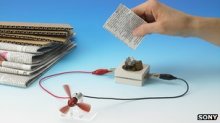Sony Shows Off Battery That "Eats" Paper
 While rechargeable batteries are taking some of the financial sting out of consumer electronics, those batteries still contain some nasty chemicals that would probably just as well not be in our landfills. With that in mind, and no doubt to tout its green clout, Sony has demonstrated a remarkable “bio-cell” that breaks down paper to create power. The demo was rolled out at Tokyo’s Eco-Products 2011 exhibition. Though the bio-cell was only powering a small fan, the potential of the new technology could be huge.
While rechargeable batteries are taking some of the financial sting out of consumer electronics, those batteries still contain some nasty chemicals that would probably just as well not be in our landfills. With that in mind, and no doubt to tout its green clout, Sony has demonstrated a remarkable “bio-cell” that breaks down paper to create power. The demo was rolled out at Tokyo’s Eco-Products 2011 exhibition. Though the bio-cell was only powering a small fan, the potential of the new technology could be huge.
Here’s how it works: The bio-cell consists of enzymes suspended in water. By dropping in a slurry of cardboard and water, the enzymes begin to break down the cellulose in the paper to produce sugar. Well, glucose, technically. Anyway, this sugar was in turn combined with oxygen and then fed to other enzymes which produced hydrogen ions and electrons. For electricity!
If you’re thinking that the process sounds a little familiar, that’s because it bears a somewhat disconcerting resemblance to how termites break down wood matter. The enzymes are, in effect, eating the paper. Fortunately, the only waste products spit out by the bio-cell are water and gluconolactone, an acid sometimes used in cosmetics.
The new bio-cell is still too small to power a PlayStation 3, but Sony’s researchers hope that it could someday lead to cheap and green power in the home. Of course, were that to happen, consumers would have to get their bio-cells from somewhere and no doubt pay for the enzymes. Perhaps the consumer electronics giant smells a new market brewing.
- Electric power from poop
- Nuclear reactor powered by poop
- 30 year batteries could be coming soon
- Sour candy is like battery acid
Have a tip we should know? [email protected]